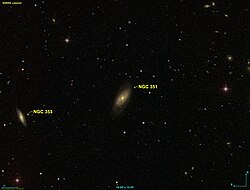| NGC 351 | |
|---|---|
 SDSS image of NGC 351 | |
| Observation data (J2000 epoch) | |
| Constellation | Cetus |
| Right ascension | 01h 01m 57.8s [1] |
| Declination | −01° 56′ 12″ [1] |
| Redshift | 0.014093 [1] |
| Heliocentric radial velocity | 4,225 km/s [1] |
| Apparent magnitude (V) | 14.06 [1] |
| Characteristics | |
| Type | SB0/a [1] |
| Apparent size (V) | 1.4' × 0.8' [1] |
| Other designations | |
| UGC 00639, CGCG 384-057, MCG +00-03-057, 2MASX J01015784-0156124, 2MASXi J0101578-015611, IRAS F00593-0212, 6dF J0101577-015612, PGC 3693. [1] | |
NGC 351 is a spiral galaxy in the constellation Cetus. It was discovered on November 10, 1885 by Lewis Swift. It was described by Dreyer as "extremely faint, pretty small, northwestern of 2.", the other being NGC 353. [2]
